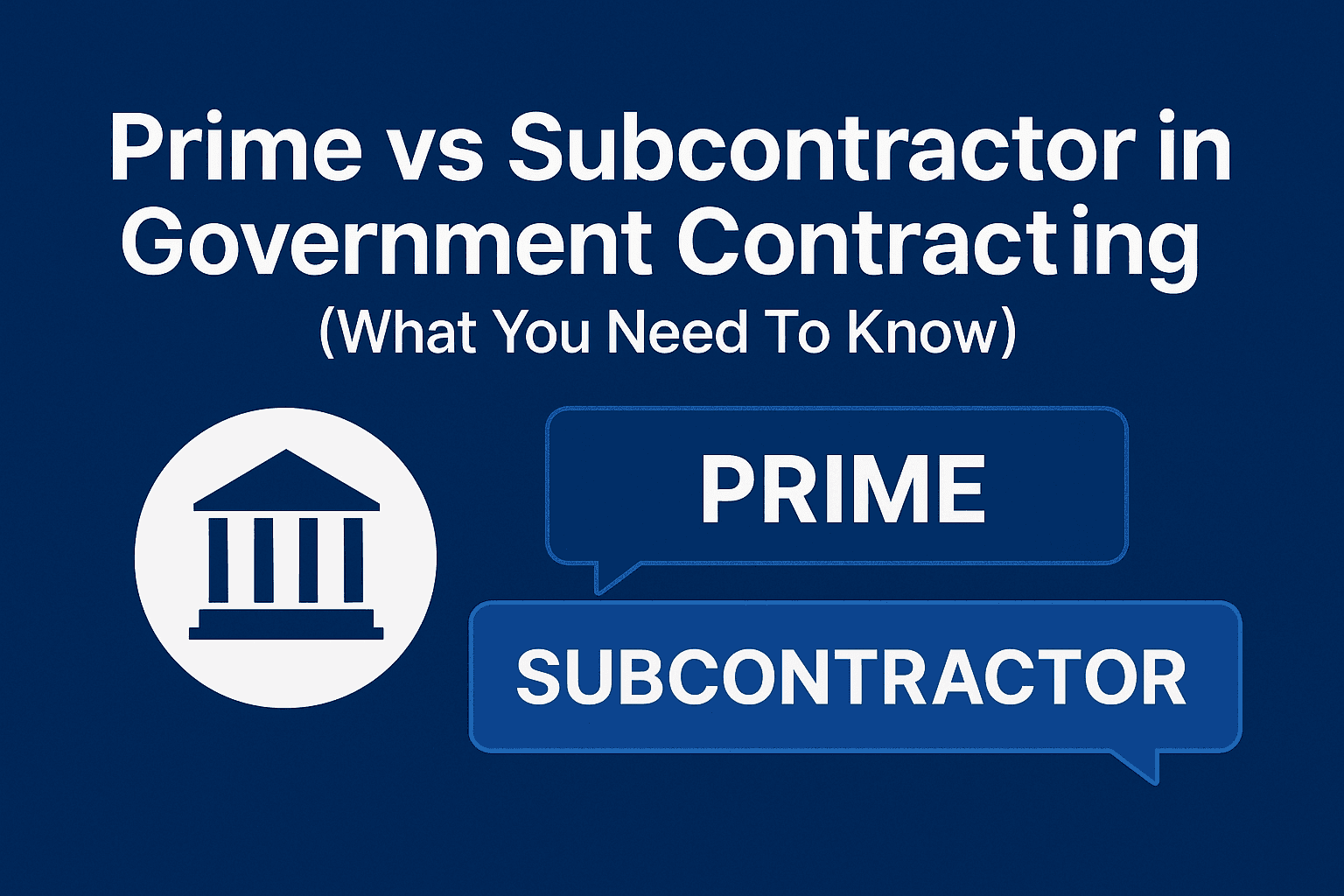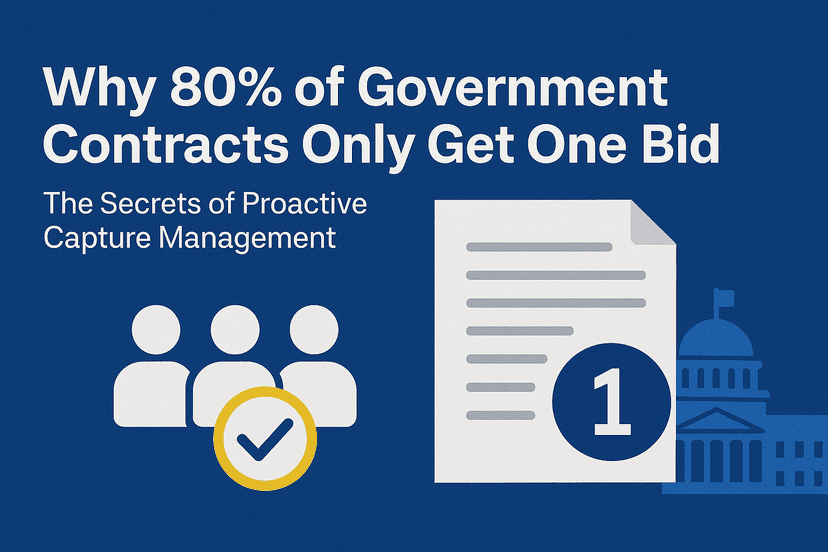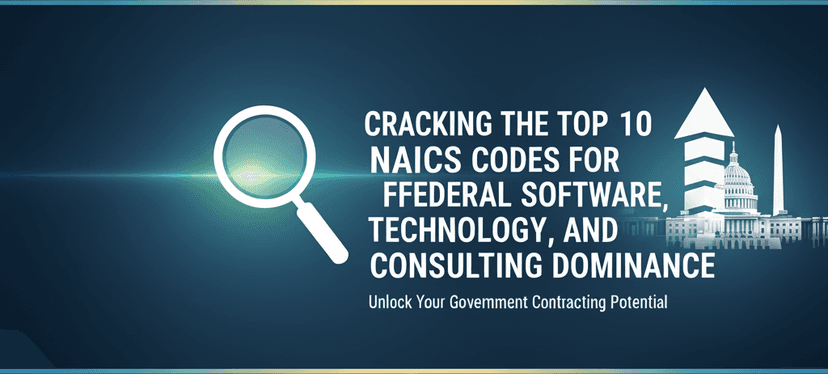Prime vs Subcontractor in Government Contracting (What You Need To Know)

🎥 Prefer video? Watch the full breakdown here:
With over $700 billion in federal contract spending in 2024, the U.S. government continues to be the largest buyer in the world. From IT services and construction to logistics and research, government contracts present valuable opportunities for businesses of all sizes.
But to win in this space, you need to understand the two primary roles:
- Prime Contractor
- Subcontractor
This article explains the key differences, benefits, and challenges of each role so you can decide what makes sense for your business.
What Is a Prime Contractor?
A prime contractor is the entity that holds a direct contract with a government agency. They are responsible for delivering the full scope of work and managing all aspects of contract execution.
Key Responsibilities of a Prime Contractor:
- Holds a direct legal agreement with the government
- Manages the entire scope, timeline, and budget
- Ensures compliance with government regulations
- Selects and oversees subcontractors
- Receives payment directly from the government
Being a prime offers more control, but it also comes with greater responsibility and risk.
What Is a Subcontractor?
A subcontractor is a business that works under a prime contractor to fulfill a defined portion of the contract. Subcontractors do not have a direct contractual relationship with the government.
Key Responsibilities of a Subcontractor:
- Works under a contract with the prime, not the government
- Completes a specific part of the project
- Reports to and is paid by the prime contractor
- Focuses on execution with less administrative burden
This role is ideal for businesses looking to enter government contracting with reduced risk and fewer compliance hurdles.
Prime vs Subcontractor: A Side-by-Side Comparison
| Category | Prime Contractor | Subcontractor |
|---|---|---|
| Legal Contract | With the government | With a prime contractor |
| Payment From | The government | The prime contractor |
| Responsibility Level | High | Moderate |
| Control | Full control over execution | Limited to assigned scope |
| Risk | High (full accountability) | Lower (limited responsibility) |
| Opportunity Size | Large | Small to medium |
Should You Prime or Sub?
Your decision depends on your experience, capacity, and business goals.
You Should Consider Priming If:
- You’ve led similar contracts before
- You’re comfortable managing compliance, audits, and reporting
- You have the team and resources to deliver large scopes
You Should Consider Subbing If:
- You’re new to government contracting
- You want to build past performance without full responsibility
- You’re a small business or solo operator with limited capacity
Benefits of Starting as a Subcontractor
Many successful government contractors start as subs. Here’s why:
- Lower Risk: You don’t carry the full contract burden.
- Learn the Process: Gain experience with government work and standards.
- Build Relationships: Work closely with primes and position yourself for future teaming opportunities.
- Develop Past Performance: Prove your value on smaller scopes to build your record.
Benefits of Being a Prime Contractor
Once you’re ready, acting as a prime contractor opens new opportunities for growth.
- Direct Client Access: You manage the relationship with the agency.
- Greater Control: Over the work, team, and budget.
- Team Building: You choose subcontractors that align with your execution goals.
- Long-Term Growth: Successful performance can lead to re-competes and extensions.
How to Find Government Contracts (Faster)
Whether you choose to prime or sub, finding the right opportunities is critical.
Tools like SamSearch simplify the process with:
- AI-powered federal, state, and local contract search
- In-platform messaging with an AI assistant to clarify opportunity details
- Proposal drafting and refinement tools
- Access to federal grants and SBIR/STTR funding opportunities
Explore more at www.samsearch.co.
Frequently Asked Questions (FAQ)
1. Is it easier to start as a subcontractor in government contracting?
Yes. Subcontracting is a common entry point for small businesses because it involves less risk, fewer compliance requirements, and allows you to build past performance.
2. Can a subcontractor work with multiple prime contractors?
Yes, as long as contract terms allow it and there are no exclusivity clauses, subcontractors can work with multiple primes across different projects.
3. How do I find subcontracting opportunities?
You can:
- Reach out to established primes in your industry
- Use tools like SamSearch to find teaming opportunities
- Attend government procurement events and industry days
4. When should I consider becoming a prime contractor?
Once you’ve built past performance, developed internal compliance systems, and have the resources to manage contracts directly, it may be time to pursue prime opportunities.
5. What certifications help with subcontracting or priming?
Certifications like 8(a), WOSB, SDVOSB, and HUBZone can increase your competitiveness for both roles and may be required for certain set-aside contracts.
Final Thoughts
Both prime and subcontractor roles can be lucrative in government contracting. The right path depends on where your business stands today and where you want to go.
If you're just getting started, subcontracting is a smart way to build experience and relationships. If you're ready to lead, priming gives you direct access and long-term growth potential.
Whatever your path, let SamSearch help you discover opportunities, draft winning proposals, and grow your government contracting business faster.
Start your search at www.samsearch.co
About Samsearch
Samsearch is an all-in-one platform that streamlines the entire government contracting process. Our solution brings together discovery, management, compliance, and proposal drafting — eliminating the need for multiple disjointed government contracting softwares.













